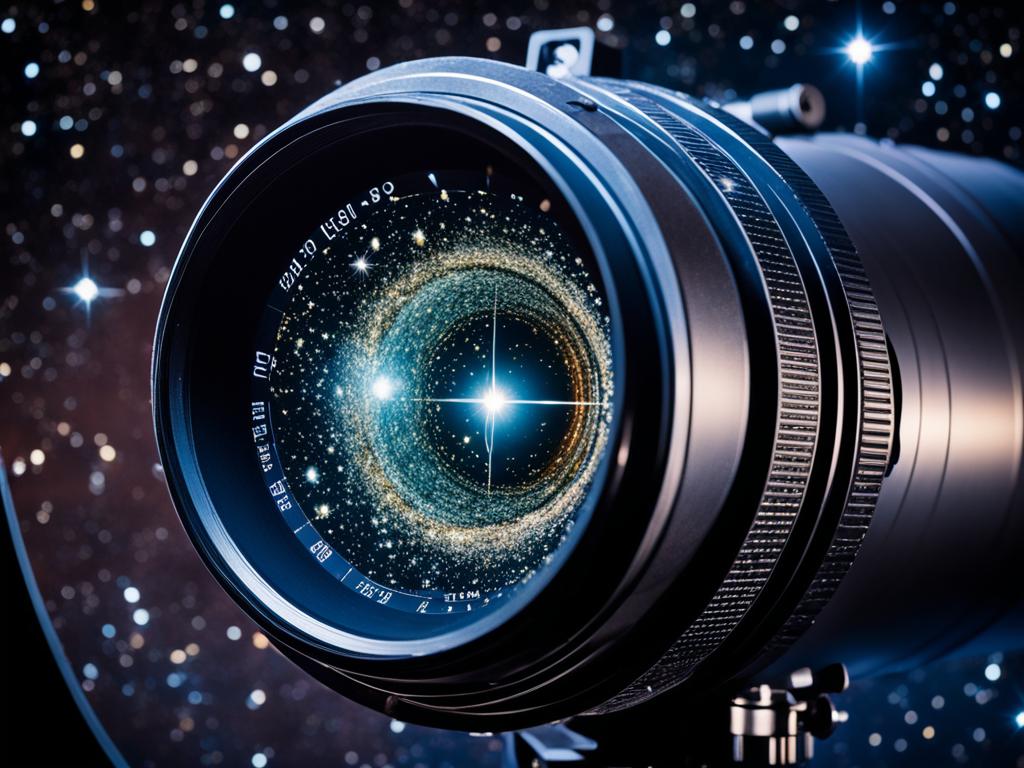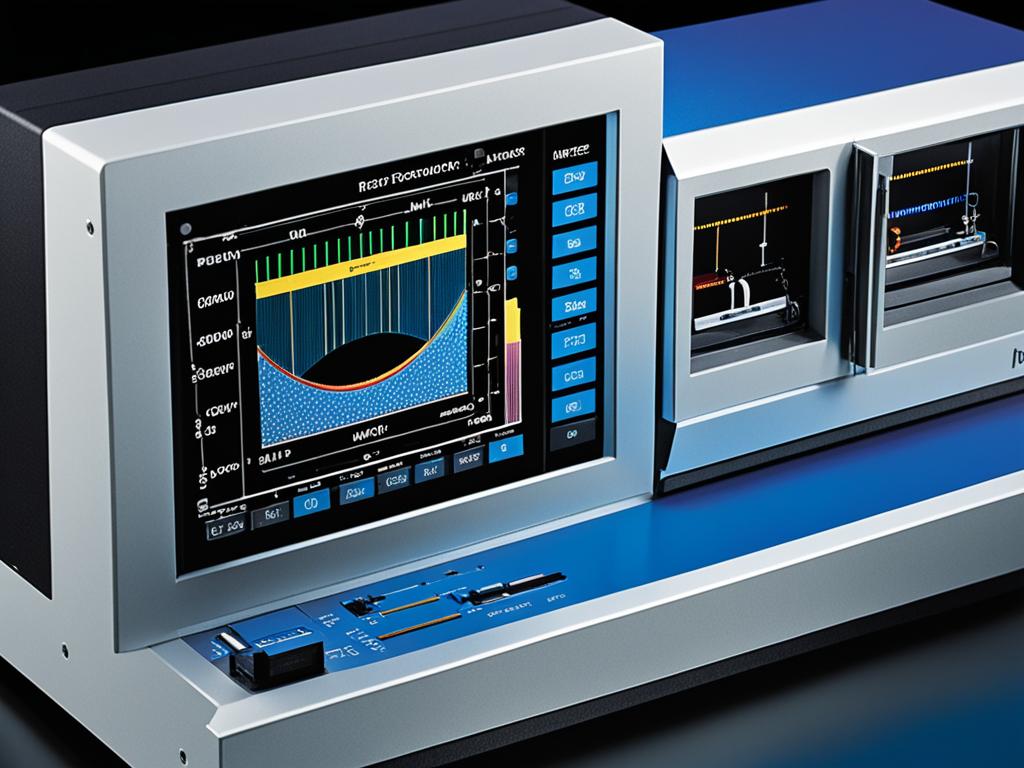In scientific exploration, optical instruments are key. They open doors to the tiny, with microscopes, and the huge, with telescopes. Ever since Galileo and Van Leeuwenhoek started, to now, these tools let us see more of our world.
Optical instruments use light to show us more. Microscopes let us see the small things, while telescopes help us look at the stars. And cameras capture these amazing sights for us to remember. Thanks to improvements in optics and imaging, we can see things clearer than ever. This helps researchers across many fields understand the world and universe better.
Key Takeaways
- Optical instruments, such as microscopes, telescopes, and cameras, have played a vital role in scientific discovery.
- These tools use light to make images better for us to see or to study their features.
- Better optics, imaging systems, and photonics have made magnifying, studying, and imaging clearer in science.
- Since Galileo and Van Leeuwenhoek, optical instruments have changed a lot.
- Types of optical instruments include interferometers, photometers, polarimeters, reflectometers, refractometers, and spectrometers.
Introduction to Optical Instruments
Optical instruments help process light waves or photons to make images clearer or to find out more about them. The earliest ones were telescopes, which made far away things look closer, and microscopes, which made tiny things bigger. Since then, these tools have gotten a lot better and can now work with different parts of the light spectrum. People use optical instruments to improve images, study light and materials, and analyze colors.
Definition and Purpose
Optical instruments change and study light for science and tech needs. They’re key in biology, medicine, space exploration, and material research. They let experts see, measure, and understand light’s various qualities.
Historical Overview
In the 1600s, Galileo and van Leeuwenhoek made the first telescopes and microscopes. These early tools set the stage for improving optics and photonics over time. As technology advanced, optical devices explored more of the light spectrum. This led to new findings and uses in areas from studying stars to working with tiny tech.
| Key Advancements in Optical Instruments | Impact |
|---|---|
| Development of high-resolution electron microscopes | Enabled detailed examination of nano-scale structures and materials |
| Advancement of adaptive optics in telescopes | Improved image quality and resolution for astronomical observations |
| Incorporation of digital sensors in cameras | Revolutionized photography and image capture capabilities |
| Integration of spectroscopic techniques in optical instruments | Facilitated advanced material analysis and identification |
Microscopes: Unveiling the Microscopic World
Microscopes are key tools in science research, helping us see tiny details for centuries. They let us explore the tiny world of biology, materials science, and nanotechnology. Without them, much of what we know today wouldn’t be possible.
Types of Microscopes
There are many kinds of microscopes, each for different uses. Optical microscopes are most common, magnifying small objects using light and lenses. Then, there are electron microscopes that use electron beams to see tiny details, even at the atomic level. Scanning probe microscopes, like the STM, examine surfaces at the nano level with very tiny probes.
Applications in Science and Research
Microscopes are vital in various scientific fields. In biological research, they help us study cells and tiny beings, adding to our knowledge in medicine and genetics. Materials science benefits as well, as microscopes study materials from the extremely small to the very large. In nanotechnology, they let us work with materials on an atomic and molecular scale, advancing areas like electronics, energy, and medicine.
As microscope technology grows, so does our ability to explore and understand the tiny world. These tools, from their early beginnings to their current advanced state, continue to change how we view our world. They have been crucial in scientific progress, unveiling secrets and guiding us towards new discoveries.
Telescopes: Exploring the Celestial Realms
Telescopes are crucial in astronomy and astrophysics>. They help us understand the celestial objects far away. Telescopes use their lenses and mirrors to gather light from space. This lets us see deep into the universe. There are many types of telescopes, like the Celestron NexStar 8SE Bundle at $1,699.95. You can also find scopes like the Coronado PST Solar Telescope for $899.99, which are great for both amateurs and experts.
There are different kinds of telescopes, like refractors and reflectors, each with special qualities. The Apertura AD8 8″ Dobsonian telescope, on sale at $649.95, is loved for its ability to see in the dark. It’s easy to use, too. The Celestron StarSense 130 DX, priced at $479.95, makes looking at stars a fun activity.
Recently, the Apertura 75Q Refractor Telescope hit the market at $1,099.95. It shows how telescopes are getting better and easier to use. For those looking to start, the Sky-Watcher Virtuoso 130 tabletop model is a good choice at $435.00.
Throughout the years, telescopes have changed the way we see the universe. They’ve taken us from our solar neighborhood to the very edge of space. Technology keeps improving, promising new revelations in astrophysics and celestial observation.

Cameras: Capturing Life’s Precious Moments
Cameras are tools that take pictures and videos. They use lenses to focus light on film or a sensor. Camera tech has changed a lot, moving from film to digital. This lets us keep, change, and share photos with ease.
People use cameras for many things, like recording memories or studying space. Some even use them to take pictures of stars and planets!
Digital Camera Technology
Digital cameras have changed how we take photos. Instead of film, they use digital sensors to capture light. Then, a computer inside the camera turns this light into a picture that we can save or edit.
This change has made photography easier for everyone. Now, we can quickly take and share photos with our friends.
Astrophotography and Celestial Imaging
Astrophotography is all about taking pictures of space. With special cameras and lenses, scientists can catch light from stars and galaxies. This helps us learn more about space’s big mysteries.
It’s not just for scientists. Many people love taking pictures of the stars as a hobby. They can even help discover new things about space.
| Optical Instrument | Magnification Capability | Applications |
|---|---|---|
| Galileo’s Telescope (17th century) | 30x | Observing distant celestial objects |
| Reflecting Telescopes (e.g., Hubble Space Telescope) | Varies, can be very high | Astrophotography, space exploration, and research |
| Compound Microscopes | Capable of high magnification | Studying small-scale biological and material structures |
| Pinhole Cameras | Low magnification | Demonstrating basic principles of optics and image formation |
Optical Instruments: Microscopes, Telescopes, and Cameras
Fundamental Optical Principles
Optical instruments work because of core optical principles. These involve how light bends, reflects, diffracts, and interferes. Knowing these principles helps improve the design and function of photonics and optical physics tools.
Lens Design and Aberration Correction
Designing lenses is key in making optical devices work. Lenses focus and change light. Lens makers think about shape, material, and coatings to stop optical aberrations. These things can mess up how things look. Better lens design and fixing aberrations has vastly improved optical devices.
| Optical Instrument | Key Characteristics | Applications |
|---|---|---|
| Microscopes | Utilize lenses to magnify small objects and structures not visible to the naked eye | Biology, medicine, materials science, nanotechnology |
| Telescopes | Collect and focus light from distant celestial objects, enabling magnification and detailed observation | Astronomy, astrophysics, space exploration |
| Cameras | Use lenses to focus light onto a light-sensitive surface, capturing and recording images | Photography, scientific research, astrophotography |
Interferometers and Photometers
Optical instruments are key in scientific research, letting researchers check light and material features closely. Two key tools are interferometers and photometers. They help measure light properties.
Measuring Light Interference and Intensity
Interferometers measure light wave interference. This tells us about materials’ optical features like their thickness. These tools find tiny changes in light wave path or phase, letting scientists look closely at materials.
Photometers look at light intensity. This is important in areas like spectroscopy and material analysis. They use photodetectors to calculate light energy. This helps researchers learn about substances’ chemicals and properties.
Both interferometers and photometers give precise measurements. They’re crucial for progress in physics, chemistry, and materials science. They allow deeper study of light and its effects on matter, leading to new discoveries and innovations.

Polarimeters and Refractometers
Polarimeters and refractometers are tools that check the light’s and materials’ features. Polarimeters figure out how light is polarized, giving clues about substances’ structure and light behavior. Refractometers, in contrast, tell us how light is bent when passing through materials.
Analyzing Polarized Light and Refractive Indices
These tools are key in many areas, from making sure products are good to use, to studying chemicals and in health science. Polarimeters show why materials interact with light differently. Refractometers work out the light bending in different materials.
With polarimeters and refractometers, experts learn more about materials they study. This helps in fields like checking materials, understanding chemicals, and in healthcare.
Spectrometers and Monochromators
Spectrometers and monochromators are key for finding out what materials are made of by looking at light. Spectrometers measure how bright light is at different wavelengths. This helps scientists see what light a material either takes in, puts out, or reflects. From this, they figure out the material’s exact chemical makeup. This makes spectrometers vital in studying materials and doing chemical analysis.
Monochromators, meanwhile, pick out certain light wavelengths from all others. They work with spectrometers, making it easier to closely study certain parts of light. Scientists and industry use them a lot. They help in checking out materials’ light behaviour, understanding light sources, and creating new optical systems.
Together, spectrometers and monochromators are a dynamic duo for studying what things are made of. They help chemists and researchers break down materials, from tiny biological samples to huge engineering materials. These tools make it possible to list and measure every atomic or molecular part of any substance. They are pushing materials science and analytical chemistry forward.
Emerging Optical Technologies
The field of optics and photonics is always growing with new technologies. These technologies include optoelectronics, quantum optics, and biophotonics. Optoelectronics combines optics with electronics, making devices that use light for communication and more. Quantum optics looks at light’s quantum behavior, which leads to quantum computing and quantum sensing.
Biophotonics uses light to study and work with living systems. This opens doors in healthcare and beyond. Laser tech is also improving, making more powerful and efficient lasers. These technologies are boosting many industries, from healthcare to defense.
Researchers are creating new materials and systems using light in smart ways. This includes merging optics with electronics in optoelectronics. The future of optical tech is very promising. It could change how we experience and learn about our world.
Source Links
- https://en.wikipedia.org/wiki/Optical_instrument
- https://www.geeksforgeeks.org/optical-instruments/
- https://www.toppr.com/guides/physics/ray-optics-and-optical-instruments/optical-instruments/
- https://store.doverpublications.com/products/9780486606422
- https://unacademy.com/content/neet-ug/study-material/physics/overview-of-optical-instruments/
- https://amscope.com/blogs/news/the-history-of-the-microscope-an-in-depth-look
- https://academic.oup.com/book/664/chapter/135354874
- https://pressbooks.bccampus.ca/collegephysics/chapter/microscopes/
- https://www.highpointscientific.com/
- https://redcarpettelescopes.com/products/national-geographic-deluxe-adventure-set-80-30103
- https://www.explorescientific.com/products/ed80-essential-series-air-spaced-triplet-refractor
- https://nerdfighteria.info/v/SddBPTcmqOk/
- https://www.pbs.org/video/optical-instruments-crash-course-physics-41-ztlrcq/
- https://www.vaia.com/en-us/explanations/physics/wave-optics/cameras/
- https://www.govinfo.gov/content/pkg/GOVPUB-C13-a008c1cd6d24c89e340ef97527e1c44b/pdf/GOVPUB-C13-a008c1cd6d24c89e340ef97527e1c44b.pdf
- https://bio-plast.net/pdf/Catalogue/Haeberle-lab/10 Optical instruments and microscopes.pdf
- https://www.census.gov/foreign-trade/schedules/b/2016/c90.html
- https://www.olympus-lifescience.com/en/microscope-resource/primer/lightandcolor/prismsandbeamsplitters/
- https://micro.magnet.fsu.edu/primer/lightandcolor/prismsandbeamsplitters.html
- https://solinstruments.com/products/confocal-microscopes/mr-series/
- https://www.photonicsonline.com/doc/emerging-technologies-optical-coatings-are-helping-to-develop-0001
- https://clarity-scopes.com/blogs/news/the-future-of-optics-emerging-technologies-and-innovations
- https://nap.nationalacademies.org/read/5954/chapter/3


